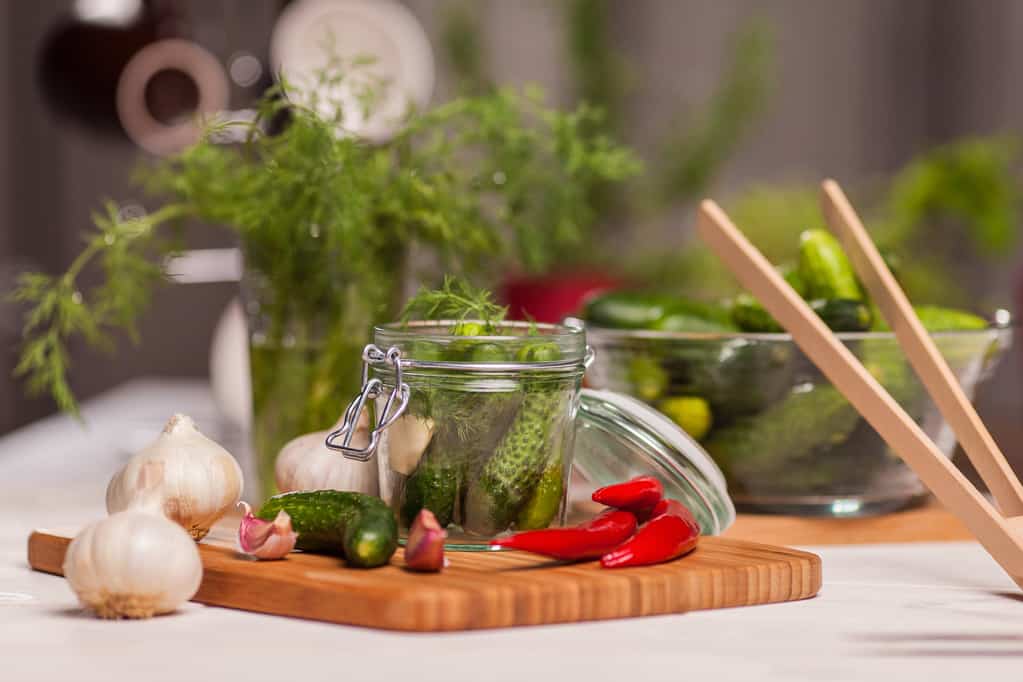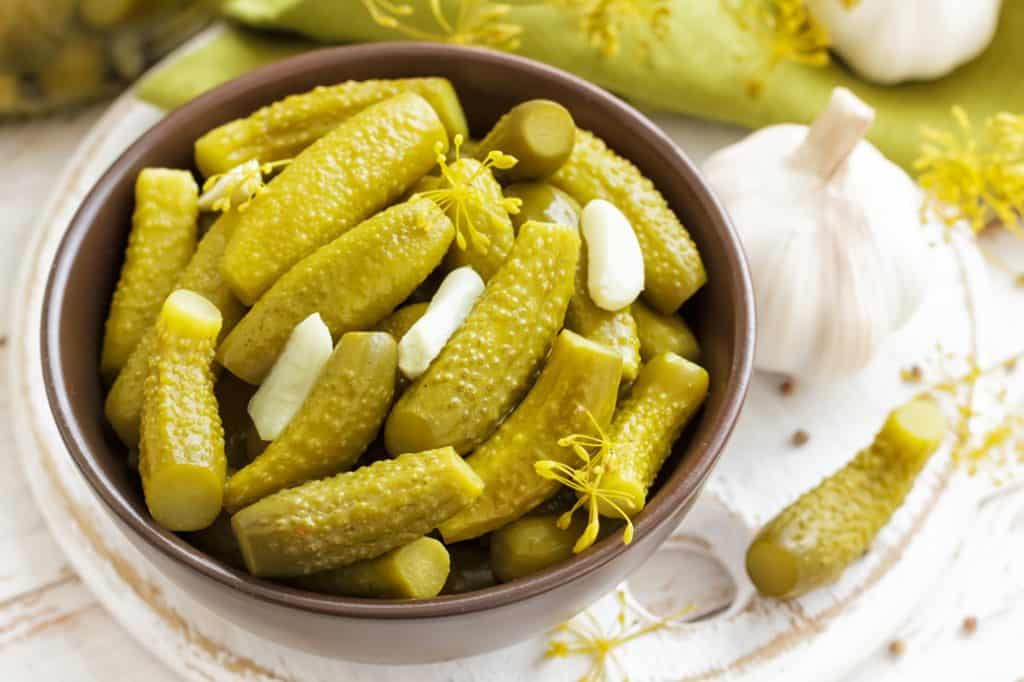![Lactic Acid Fermentation in Food [Explained]](https://myfermentedfoods.com/wp-content/uploads/2018/10/1F.jpg)
Lactic acid fermentation of fruits and vegetables has been around for centuries. Records indicate that foods like kimchi may have been eaten even in the third and fourth centuries.
Lactic acid fermentation of raw veggies results in savory pickles that make a delicious and spicy accompaniment to meals.
This type of fermentation is just one of the kinds of fermentations used for preserving food.
Other types of fermentation such as acetic acid fermentation, alcohol fermentation, and carbon dioxide fermentation also exist and each comes with its own set of unique features, health benefits, and pros and cons.
Lactic acid fermentation has been extensively researched and its benefits are well documented.
What happens during lactic acid fermentation?
The key benefit of fermenting foods like vegetables and fruits is that they can last for a year or more without spoilage.
Prior to fermentation, produce harbors a lot of bacteria including aerobic spoilage microflora species like yeast and bacteria. The cell populations of these microorganisms range from 10,0000 to 10,000000 CFU/grams where CFU stands for Colony Forming Units.
Brining vegetables and fruits introduces Lactobacillus or Lactic acid bacteria (LAB) which includes organic acids and a variety of antimicrobial elements.
During fermentation, the organic acids diffuse into the brine and lower the pH of the solution. pH value of a solution is a measure of its acidity or alkalinity.
So on a scale of 0 to 14, a pH of 0 is highly acidic and a pH of 14 is highly basic. 7 is neutral pH.
This low pH that results during fermentation influences microbial growth across the surface of vegetables. This, in turn, causes sugars from the vegetables to diffuse into the brine which fuels the growth of LAB.
The LAB or lactobacillus bacterium is more acid resistant than the spoilage microorganisms.
The resulting food is resistant to spoilage and has a sour, salty and sharp taste.
What does LAB contain?
Lactic acid fermentation is carried out by several different genera of bacteria.
Nearly 11 different genera comprise of what is collectively known as LAB. The lactobacilli are the most important genera as far as fermentation is concerned, since it can carry out respiration even without oxygen. Carbohydrates such as glucose, sucrose and fructose found in the vegetables are partially oxidized with the release of energy and their breakdown results in lactic acid formation.
The fermentation caused by lactobacillus bacterium does not need oxygen to be present. Because of this, lactic acid fermentation does not drastically alter the composition of food.
The entire basis of Lactic acid fermentation is formation of acid that inhibits growth of non desirable organisms.
Different LAB are tolerant of different temperatures and acid concentrations. They also produce different compounds that give pickles their characteristic tastes.
Here are the main groups of LAB and the compounds they produce:
- Leuconostoc mesenteroides – produce acid and gas
- Lactobacillus plantarum – produces acid and a small amount of gas
- Lactobacillus cucumeris – produce acid and a small amount of gas
- Lactobacillus pentoaceticus – produce acid and gas
Factors affecting fermentation
Some fermented foods need a starter culture. Others such as fermentation or pickling of vegetables undergo self or spontaneous fermentation.
Several foods like yogurt and kombucha need a starter culture. This process is known as back slopping where a beverage or food that has undergone successful fermentation is reserved and used to inoculate a new batch.
This may be a crude method, but back slopping is highly effective. Several other factors also affect fermentation:
- pH – in certain foods the pH of yeast produced can have a wide pH range though a value of 4-4.5 is favored. LAB grows at a pH of less than 4 and when the lactic acid is produced the pH goes down further. Many spoilage bacteria cannot grow at lower pH. This has consequences on the shelf life and safety of food. Lactobacillus and streptococcus species are acid tolerant.
- Moisture – The presence of water or moisture in food will control the microbial growth.
- Nutrient content and composition of food – This also influences the type of fermentation. Yeasts tolerate much higher levels of sugars than bacteria so under high sugar conditions, alcoholic fermentation is preferred. All fermenters need sugars like glucose or fructose or even complex ones like cellulose or starch. Limiting the amount of substrate can reduce the rate of fermentation.
- External or ambient temperature is a crucial factor during fermentation. LAB tend to grow best when ambient temperature is between 68°F and 90°F (20 degrees C and 32 degrees C). Certain lactobacillus species also will grow at higher temperature between 118°F and 122°F (48 to 50 degrees C).
- Salt concentration – The percentage of salt in the brine affects the fermentation process greatly. Some foods like kimchi are fermented at lower salt concentrations like 2 to 3% which is favorable for lactic acid bacteria to grow. In fact, at lower salt concentration of less than 2%, acidification of kimchi was seen to have occurred rapidly with rapid growth of lactic acid bacteria. On the other hand, for salt concentration over 3%, there was a delay in fermentation and ripening of kimchi.
- Oxygen availability – Some fermenters are anaerobic while some require oxygen. Certain lactobacilli are microaerophilic which means they grow in the presence of reduced amounts of oxygen.
Let’s see now how this lactic acid fermentation process works in practice by using pickles, cucumbers, and kimchi as examples.
Fermenting Pickles
Preparation of Fruit and Vegetables
- The produce (fruits or vegetables) should be fresh and slightly under-ripe. Discard damaged, bruised or infected produce.
- Wash the produce in clean water
- Peel and remove stones or pits.
- Use stainless steel knives to cut the produce into pieces. Make sure the pieces are uniform in size. Cutting the fruit or vegetables into strips is best in most cases. You can also use a shredder.
- Use scales to weigh the produce for each batch. You can use two sets of scales – the larger set for produce and sugar or salt and smaller for spices.

Fermentation
- Place the prepared vegetables in the fermentation container. Always use a container with a lid. This will help maintain temperature and also protect the ferment from dust and insects.
- If you are adding spices, then use clean, good quality spices. You can roast or fry the spices before adding. The amount and type depend on the personal taste.
- Add salt or brine. Weigh down the vegetables completely with brine. You can also add vegetables and salt in alternating layer until the container is 3/4th full. You need 3 kilos of salt per 100 kilos of vegetables.
- If you use brine, prepare 15-20% brine solution by dissolving salt in water. Use a brine tester or brine hydrometer to measure this.
- If needed, add starter culture of juice from previous ferment. This will help speed up fermentation.
- Optimum temperature for fermentation is 70°F or 21°C. Maintain the temperature carefully.
- Fermentation begins as soon as brine is formed. You will see carbon dioxide bubbles being formed.
- It can take anywhere between 1-4 weeks for fermentation process to complete depending on the strength of salt solution, the ambient temperature and the pH.
- Fermentation is complete when no more bubbles appear.
It is important that the salt concentration of the brine does not fall below 12% as fermentation will not be able to take place. You can add salt periodically to maintain strength of brine.
Simple recipe of pickled cucumbers
Ingredients
- 15-20 medium sized cucumbers; select ripe cucumbers that are free from bruising. You can pickle them whole or sliced. If slicing, cut into 5-8 cm pieces.
- 1 kg salt.
Method
- Wash the cucumbers in clean, cool water.
- Place cucumbers and salt in alternate layers in a container with lid. Seal the container. A brine will begin to form.
- You need to ensure that the brine submerges the cucumbers completely. If not, you need to prepare brine separately and add over the cucumbers. Use at least 40 degrees Salometer brine and add to the container. (A salometer also known as a Salinometer, brine hydrometer or salimeter is a hydrometer that measures the percentage of salt in a solution. For light brine, get a reading of at least 10% of salt by weight. For heavier brine, reading on the meter would be above 25 degrees). You can use our Brine Calculator to calculate the required salt to water ratio.
- Fermentation starts as soon as bubbles start rising.
- Leave the pickles to ferment for 1-4 weeks. This time period depends on the ambient temperature.
- Pickle is ready when no more bubbles rise.
Store the pickles in clean, sterile jars and close the lid tightly. Keep it in a cool place.

Simple Kimchi recipe
Kimchi is one of the oldest fermented foods that might have been around for the past 2000 years. There are more than 150 different variations to the basic kimchi. The following recipe is rather simple and does not need any fish sauce, daikon radish or chili paste.
Ingredients
- 2 large heads of Napa cabbage sliced thinly
- Green onions – 2 large bunches – sliced
- 1 head of garlic minced
- 1-2 tbsp ginger grated
- 1-2 tbsp red pepper flakes
- 3-4 tbsp salt
Method
- Combine all ingredients in a large bowl.
- Massage the salt into the veggies.
- Crush the veggies using a cabbage crusher to release juices.
- Keep pounding until enough liquid is formed. Ideally the liquid should cover the veggies.
- Place the mixture in clean, sterile glass jars and press the veggies down into the brine.
- Cover the jar with a tight lid.
- Culture at 65°F to 70°F (18°C to 21°C) until desired texture and flavor is achieved. You might have to burp the gas daily if you are using an airtight lock seal. This helps release pressure.
- Once the kimchi is done, store in tightly sealed jar in a cool place. The flavor will continue to develop as the kimchi ages.
References
- Pickles, The Food and Agriculture Organization (FAO)
- Fermented Vegetables, Food, Bioprocessing, and Nutrition Sciences Department, NC State University
- Lactic Acid Fermentation of Fruits and Vegetables, Spiros Paramithiotis
- The Noma Guide to Fermentation: Including koji, kombuchas, shoyus, misos, by René Redzepi, David Zilber.

Hello, I’m Kim Soyeon, a Korean. Thank you for introducing Kimchi. It’s really good because it’s written in detail about the benefits of fermentation. However, I think it would have been better if you wrote down that Kimchi is a Korean food. Thank you for loving Kimchi.
Hello Kim, Thanks for your suggestion and I’m glad you found the post helpful. I’ve written a kimchi specific post which mentions that kimchi is Korean food 🙂